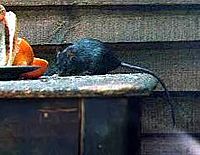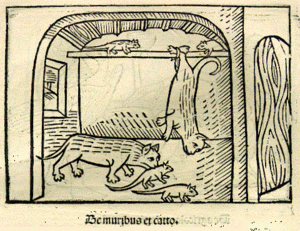Muridae facts for kids
Quick facts for kids MuridsTemporal range:
early Miocene – Recent |
|
|---|---|
 |
|
| Black rat (Rattus rattus) | |
| Scientific classification | |
| Kingdom: | |
| Class: | |
| Order: | |
| Superfamily: | |
| Family: |
Muridae
|
| Subfamilies | |
|
Deomyinae |
|
Muridae is the largest family of mammals on Earth! It includes over 700 different kinds of animals. You can find them naturally in places like Europe, Asia, Africa, and Australia. But people have also carried them to almost every other part of the world. This big group includes animals you might know well, like true mice, rats, and gerbils.
The name Muridae sometimes refers to an even bigger group called Muroidea. Scientists divide the Muridae family into four main groups, called subfamilies. There are also about 140 different genera (smaller groups) within them.
Contents
Where Murids Live
Murids live almost everywhere on our planet. However, many of their subfamilies have smaller areas where they are found. You won't find murids in Antarctica or on many small islands in the ocean. Even though they didn't originally come from the Americas, a few types, like the house mouse and black rat, have spread there with humans.
Murids live in many different kinds of places. These range from hot tropical forests to cold tundras. Some murids live underground, while others live in trees. Some even live near water. But most murids live on the ground. Because they can live in so many different environments, there are a lot of them!
What Murids Eat
Murids eat a wide variety of foods. Some are herbivores, eating only plants. Others are omnivores, eating both plants and small animals. Some are very picky eaters. They might only eat earthworms, certain types of fungi, or even water insects.
Most murids eat plants and small bugs. They often store seeds and other plant parts to eat during winter. Murids have special jaws and a gap in their teeth. They don't have canine teeth or premolars. They usually have three molars, but sometimes only one or two. The shape of their molars changes depending on what they eat.
Murid Reproduction and Life Cycle
Some murids like to live in groups, while others prefer to be alone. Female murids often have several litters of babies each year. In warm places, they might have babies all year long. Most murids don't live longer than two years. But they can have many babies quickly. Their populations can grow very fast. Then, they might drop sharply when there isn't enough food. This often happens in a three- to four-year cycle.
Murid Characteristics
Murids are usually small mammals. They are typically about 10 cm (4 inches) long, not counting their tails. But they can range from 4.5 cm (1.8 inches) in the African pygmy mouse to 48 cm (19 inches) in the southern giant slender-tailed cloud rat. They often have thin bodies with scaled tails that are longer than their bodies. They also have pointed noses with long, noticeable whiskers.
Some murids have long legs and feet. This helps them move by hopping. Others have wide feet and tails that can grip things. This helps them climb better. Most murids are some shade of brown. But many also have black, grey, or white markings.
Murids generally have excellent senses of hearing and smell. They live in many different places, from forests to grasslands and mountains. Many types, especially gerbils, are good at living in deserts. They can survive a long time with very little water. They eat many different foods, depending on the species. They use strong jaw muscles and sharp incisors (front teeth) to gnaw. These incisors keep growing throughout their lives.
Murids breed often. They usually have large litters several times a year. They typically give birth between 20 and 40 days after mating. This time can be different for each species. The babies are usually born blind, without hair, and can't do much on their own. But there are some exceptions, like spiny mice.
How Murids Evolved
It's hard to know exactly how murids evolved. This is true for many small mammals because not many fossils of them survive. Scientists think they probably evolved from animals similar to hamsters. This happened in tropical Asia during the early Miocene epoch. Later, they developed ways to live in colder places. They became very common around the world during the Holocene epoch. This is because they often traveled with humans as people moved to new places.
Murid Subfamilies
- Deomyinae (spiny mice, brush furred mice, link rat)
- Gerbillinae (gerbils, jirds and sand rats)
- Leimacomyinae (Togo mouse)
- Lophiomyinae (Crested rat)
- Murinae (Old World rats and mice including the vlei rats)
Murids in Stories

Murids appear in many stories, including folk tales and fairy tales. In the story of The Pied Piper of Hamelin, a rat-catcher uses his pipe to lead all the town's rats into a river. But the mayor won't pay him. So, the rat-catcher takes all the town's children away, and they are never seen again.
Mice are also in some of Beatrix Potter's books. These include The Tale Of Two Bad Mice (1904) and The Tale of Mrs Tittlemouse (1910). The Tailor of Gloucester (1903) was a favorite of J. R. R. Tolkien. He said it was like a true fairy story.
Some of Aesop's Fables also feature murids. These include The Cat and the Mice and The Frog and the Mouse. In James Herbert's first novel, The Rats (1974), a homeless man is attacked and eaten by giant rats. More attacks follow in the story.
See also
 In Spanish: Múridos para niños
In Spanish: Múridos para niños


